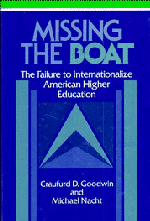Book contents
- Frontmatter
- Contents
- Introduction
- 1 Higher education looks abroad: historical trends
- 2 Who goes today? and who does not?
- 3 Individual costs and benefits
- 4 Campus attitudes
- 5 Obstacles to international experience
- 6 Issues for debate
- 7 Cases studies
- 8 Epilogue: missing the boat
- Appendix: institutions visited
- Index
2 - Who goes today? and who does not?
Published online by Cambridge University Press: 04 August 2010
- Frontmatter
- Contents
- Introduction
- 1 Higher education looks abroad: historical trends
- 2 Who goes today? and who does not?
- 3 Individual costs and benefits
- 4 Campus attitudes
- 5 Obstacles to international experience
- 6 Issues for debate
- 7 Cases studies
- 8 Epilogue: missing the boat
- Appendix: institutions visited
- Index
Summary
In this chapter we identify and discuss categories of faculty who went abroad, and those who did not, from the United States in the late 1980s. This categorization is based on detailed discussions with upwards of a thousand persons on U.S. campuses. The fineness of grain selected for the categories is a matter of taste; the main criterion is that the categories be usefully distinct. There are various ways to go about the categorization. For example, a case can be made for an organizing distinction based upon experiences devoted to, respectively, the three legs of the stool of faculty responsibility: teaching, research, and service. Faculty do, indeed, go abroad for all three of these purposes. We choose instead, however, a first cut based on whether an overseas experience is aimed at professional or personal gain, recognizing, of course, that the two objectives may sometimes be tied together. We discern five categories of those who go abroad with a professional mission. We also find six subcategories of faculty who cannot or do not by choice go abroad for extended periods at all. We hope we provide enough illustrative detail to make this taxonomy both comprehensible and useful.
We became very aware during our explorations that certain background characteristics lying behind all of these categories tend to predetermine the disposition of faculty for an overseas experience. In particular prior foreign travel seems a significant determinant of subsequent interest.
- Type
- Chapter
- Information
- Missing the BoatThe Failure to Internationalize American Higher Education, pp. 11 - 36Publisher: Cambridge University PressPrint publication year: 1991



